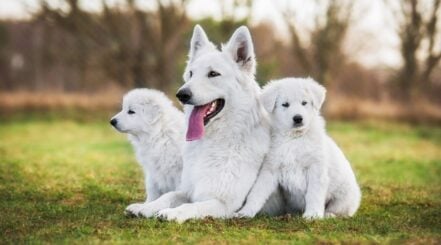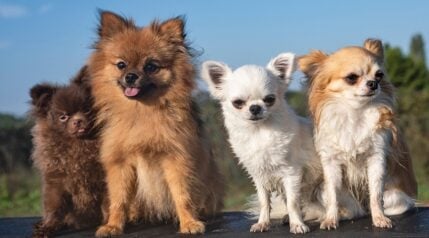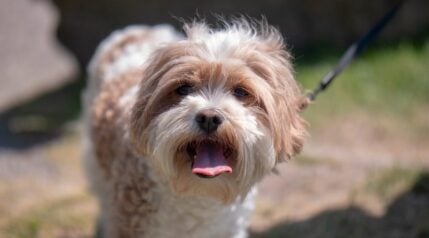The Shih Tzu and the Yorkshire Terrier mixed breed, also known as the Shorkie, is a small and feisty guy who has a lot of character squeezed into his small body. He is a very stubborn dog who needs a consistent master who is not going to give up on his training, because if he is not reigned in he can become problematic.
The Shorkie has become an extremely popular mixed breed over the last several years, specifically because of their fiesty nature. It’s not a bad thing, but these pups have lots of energy and need a firm training approach. But if you can handle him, then he is a lovely canine companion, who has the loyalty of a lion!
This pup is a great smaller breed that has a pretty long lifespan. We believe that there is a perfect dog out there for everyone, so read on to find out if the Shorkie is the perfect dog for you and your family!
Parent Breeds
A designer dog is a new label that the media have created, and whilst it sounds a bit posh, it is a practice that has been around for centuries, if not longer. A designer dog is simply a puppy who has two different purebred parents, and in this case the Shorkie’s parents are the Shih Tzu and the Yorkshire Terrier.
Whilst designer dogs cannot be registered with kennel clubs such as the American Kennel Club or the United Kennel Club, they can be registered with the American Canine Hybrid Club (ACHC), and most reputable breeders will have their Shorkie litters registered with leading hybrid clubs such as this.
Many new designer dogs can inherit any combination of genes from either parent, so you need to be sure that you like both of his parents and that they would both suit your lifestyle. For this reason, it is important to know a little bit about each of his parents.
Shih Tzu
The Shih Tzu’s journey began in either Tibet or China, and whilst his origins aren’t entirely clear he is believed to be one of the 14 oldest dog breeds in history. He was originally bred to be a companionship dog. His nickname, ‘the lion dog’ comes from the Ming Dynasty in the 14th Century China, where he was described in documents as a small dog who strongly resembled lions.
In 2019, the Shih Tzu was ranked by the American Kennel Club (AKC) as the 20th most popular dog breed in America. He is part of the Toy Group, and he is described as affectionate, playful and outgoing, and this is where the Shorkie get’s his sweet side from. The Shih Tzu is often cross-bred with other purebreeds, like the Chihuahua Shi Tzu cross.
Yorkshire Terrier
The Yorkshire Terrier’s journey began in Northern England in the mid-19th Century. When Scottish coal miners relocated to Yorkshire, they took their Clydesdale Terriers with them, and here they were crossed with smaller Terriers, believed to be the Tan Toy, Skye and Waterside Terriers. He was first used to catch rats in the mines, and despite being a small ‘handbag’ sized dog, he is very much a Terrier! They also come in teacup sizes as well.
In 2019 the Yorkshire Terrier was ranked by the AKC as the 10th most popular dog breed in America. He is also part of the Toy Group, and he is described as affectionate, sprightly and tomboyish, which is where the Shorkie gets his cheeky side from. The Yorkie is often cross bred with other purebreds to make mixes like the Chorkie, or like the Maltese Yorkie Mix.
The Shorkie
The Shorkie is a relatively new breed, and as such most Shorkies will be first generation pups, technically known as F1 pups, who have one Yorkshire Terrier parent and one Shih Tzu parent. For this reason, most Shorkie’s appearances and temperaments are variable from pup to pup.
If you aren’t too keen on the idea of playing the appearance and temperament lottery then you should seek a breeder who breeds Shorkies together, and therefore creating second and third generation Shorkies, as they are more consistent in their appearance and personality. This guide will talk about the typical Shorkie, but as with any cross breed you can expect some variations.
Temperament
Just like most small dogs, the Shorkie has a big personality trapped inside that small body of his. He is full of beans and whilst he does make a great lap dog he is known for his small outbursts of energy, so prepare some room in your home for the zoomies to take place. On top of that, he is quite the spoilt little guy who is very stubborn. With his big personality comes big doggy tantrums if he doesn’t get his own way!
He is bred to be a companion dog, and he takes this role very seriously. Both of his parents are known as ‘velcro dogs’ and this guy is twice as clingy. Some owners may find this trait adorable whereas some may find this far too intense, so before you commit to the Shorkie make sure that you are happy for him to stick to you like glue.
This trait also creates a problem of its own, in that the Shorkie does not like to be left alone for too long, so he needs to be with a family that aren’t going to be out from 9am to 5pm every day. But with him being tiny enough to fit into your handbag we can’t see any reason why you would have to leave him at all!
His loyalty means that he is always alert to what danger could be around his master, so you should expect a small little watchdog who barks a lot! If it is a small guard dog that you are after then the Shorkie makes an excellent choice, but if you aren’t a fan of noisy dogs, then you should consider another dog breed altogether. His barking is a sign of distrust for others, and he can be quite aloof with strangers. It may take some time for him to warm up to strangers, but once he does he is a little sweetheart really!
Size & Appearance
The male Shorkie will measure between 6 to 9 inches from paw to shoulder, and the female Shorkie will measure 5 to 8 inches. The male Shorkie will weigh between 5 to 11 pounds, and the female Shorkie will weigh between 4 to 8 pounds. So, this small toy dog will slip straight into your purse with no issues!
He will look a bit like both of his parents, and there are no set rules to his looks if he is a first generation puppy. Typically, he has thin legs, and whilst they are tiny they do have proportionate muscle on their body under all that fur. He will tend to have a rounder face than the Yorkshire Terrier, and there is a chance that he may inherit the Brachycephalic face of the Shih Tzu, which we will explain further in the health section. His tail will be thin and slightly curled, and on excitement it may stand erect and curl slightly over his back.
Coat & Colors
The Shorkie’s coat will be long, straight, and silky to the touch. Both of his parents have hair that can grow down to his paws, and whilst some owners may prefer this look, it does require a lot of time and effort, so most owners opt for a teddy bear cut, which is a natural looking cut that follows the contours of his body. When his hair is cut a bit shorter it can look wispy. If his hair is kept long around his face then owners tie it up into a clip so that he can actually see!
The Shorkie does not have a typical color, and it can be absolutely any variation of either parent. As such, the Shorkie can enjoy a mixture of black, blue, gold, tan, brindle, white, liver, red and silver colors in any pattern.
His Yorkshire Terrier parent is a hypoallergenic dog, and whilst this doesn’t necessarily mean that the Shorkie will be, it does mean that he is a low shedding dog who is better suited to families with slight allergies more so than a heavy shedder, like the Bernese Shepherd. Of course, if you are seeking a hypoallergenic dog then you should stick with a purebred Yorkshire Terrier, or other hypoallergenic dogs.
Exercise & Living Conditions
The Shorkie does not require a huge amount of exercise, but he still needs slightly more than the average toy dog breed. Around 30 minutes of exercise a day outside the home will suffice as he will likely have several energy outbursts throughout the day that we described earlier, and these will also help to wear him out. He might try to persuade you that he doesn’t need any exercise, and that he would rather stay in the comfort of your lap, but he still needs to be exercised regardless, so you need to be more stubborn than him here.
Be sure to monitor him during exercise as he can often struggle to breathe normally because of his Brachycephalic condition. If it is a hot day then be sure to only exercise him early in the morning or in the evening once it has cooled down, and if it is still too hot it is suggested to forget exercise altogether until conditions become cooler.
This guy is adaptable when it comes to his living conditions, and he is suited to both large homes and apartments, and anywhere else in between. To be quite honest, he doesn’t really care, just as long as there is a warm lap to relax on and treats to eat, he is a happy pup. Just be sure to check the security of your home and yard, for he can squeeze through the tiniest of gaps.
Because of his compact size he is only suited to families with older children, simply because these pups are so delicate and there is a chance that a child may accidently hurt him. He should only be placed with children who understand how to handle a dog of this size.
The Shorkie is fine with other pets, so long as he grows up with them as a puppy. However, it is unlikely that he will take kindly to pets being introduced to the family home if he is used to being the only family pet. He is also intolerant of annoying playmates, so whilst he may be okay in a multi-pet household, he isn’t a certain contender for this role, so you might want to consider another dog breed if this is really important to you.
Training
Despite his high intelligence he isn’t always interested in participating in training sessions, agility courses or other games. He is a very stubborn little guy, just like both of his parents, and this stubbornness can make him quite a difficult dog to train. This can be frustrating, but it is something that you need to consider because, just as you can’t make a Leopard change his spots, the Shorkie’s stubbornness is not going to change anytime soon!
Clicker training is a very useful method of training for independent dogs, and here are 7 tips for training a stubborn dog, but whatever you do, be sure to utilize reward based training. Make every training session short so that he doesn’t get bored and reward him with small treats to keep him interested. Overall, you need to be persistent and don’t give into his stubbornness, as the last thing you want is a spoilt Shorkie who doesn’t listen to you. Having Shih Tzu sized toys will help get some of his energy out.
It is also really important to ensure that he is socialized as early as possible to ensure that he is polite and friendly with other dogs. Whilst his small stature might make him seem innocent and incapable of causing harm, his ‘little dog’ attitude can cause problems with other dogs who don’t appreciate his yappy barking. It is also important to ensure that he doesn’t become too overprotective of his master, as his strong attachment can manifest in aggression, and early socialization and boundary setting can help to ease this. If you plan to train your pup on a leash with a harness, make sure you get a harness that’s fit for smaller dogs.
Health
The Shorkie is known to suffer with Patella Luxation, which is where his kneecap becomes dislocated which can cause him a lot of pain. Both of his parents are known to suffer with Portosystemic shunt, which is where his kidneys are unable to detoxify his body waste, and this will eventually cause a fatal build up of toxins in his body. The Shorkie is also known to suffer from a variety of eye conditions, with Glaucoma and Lens Luxation being the most common and problematic, and they are also often interlinked.
Toy dogs are also known to suffer with toy size related health issues, and the Shorkie is no different. Because of his tiny mouth and jaw, he can suffer with a variety of dental problems, such as periodontal diseases and overcrowded teeth. Hypoglycemia is also an issue with smaller dogs, in that they cannot store enough glucose, and this can prove to be fatal if not managed properly.
As mentioned above, his Shih Tzu parent is considered to be a Brachycephalic dog, who with his flat face and shortened muzzle often finds it difficult to breathe, especially during exercise and in hot conditions. For this reason, his breathing needs to be constantly monitored, and if you notice any difference in his breathing then be sure to return him to a calm state and monitor him.
Despite all of the above health conditions he is known to live between 11 and 16 years.
Nutrition
The Shorkie will eat around 1 cup of food a day. Because he is prone to Hypoglycemia as described above, he should be fed his recommended food across different meal sittings throughout the day to ensure that his blood sugar levels remain consistent.
It is important to feed him high-quality kibble that provides him with all the nutrients that he needs, just be sure it is specifically for toy dog breeds so that he can fit the biscuits into his mouth.
Grooming
The Shorkie can have long hair like both of his parents, but the majority of owners keep his hair clipped and trim. Because of his quick growing hair, he will need to be clipped every 8 weeks or so. Brushing 2 to 3 times a week will ensure that his hair doesn’t become matted or tangled, and it keeps him looking neat and healthy.
Because he is prone to periodontal diseases, his teeth need to be cleaned at least once a week with doggy toothpaste, to ensure that buildup of plaque doesn’t become an issue and that his breath is kept as fresh as possible.
Puppy Costs
A Shorkie will cost, on average, between $500 and $1,000. If you are seeking a second generation Shorkie then it is likely that breeders will charge more for these guys, because a little more time and effort has gone into the process of mating Shorkies with Shorkies. With that higher price tag comes a little more certainty of what characteristics to expect, and this is really just down to personal choice.
As Family Pets
- A Shorkie is a small little guy who makes a great lap dog.
- This pup may have small outbursts of entertaining energy throughout the day.
- He needs around 30 minutes of exercise a day.
- He should be place with an active family.
- He is suited to apartment living, just be sure he can’t escape through small areas.
- The Shorkie is better placed with older children who won’t squeeze or accidently drop him.
- He may be fine with other house pets as long as he grows up with them from a puppy.
- The Shorkie is terribly independent and he won’t be the most loyal or obedient of dogs.
- His barking and potential over-protectiveness needs to be consistently corrected.
- This breed shouldn’t be allowed to rule the roost.
- He has several health conditions that need to be closely monitored.
Finding A Shorkie Breeder
It is important to work with Shorkie breeders who are both reputable and ethical. There are a lot of breeders who are only interested in making a quick buck from the toy dog designer trend, so you need to thoroughly research them and their credentials before buying a puppy from them. Only reputable breeders will breed dogs who are healthy, so be sure to ask to see his parents health certificates, as well as their living conditions so that you know that your pup is healthy and has bad the best start to life.
Rescue & Shelters
There are plenty of dogs who are in need of adoption and their forever home, and rescuing a dog is such an amazing thing to do! There are plenty of dog shelters around so visit them as often as you can in order for you to find your Shorkie soulmate.
To increase your chances, even more, focus on breed-specific shelters, such as the Yorkshire Terrier National Rescue Inc and the Shih Tzu Rescue Inc, who also rehome their breed mixes.
Final Thoughts
The Shorkie is a gorgeous little guy who has a lot of love and affection to give his master. As long as you are open-minded and prepared to expect characteristics of either of his parents, then you will definitely not be disappointed with him. But you can expect a loyal, fun, and loving pooch, with a splash of doggy drama thrown into the mix. So, all you need to decide now is whether the Shorkie will make your perfect little sidekick!






I have a Shorkie that just turned one.She is very intelligent. Was pretty easy to crate train. She’s high energy and loves to play fetch with her balls and other toys. I’d like to breed her to a Shorkie or a Maltese. If I can find another Shorkie, I’d breed her.
I have a 6 yr old Shorkie named Moses. His two companions are a 7 yr old Cavachon mix (Bella) and an 11 yr old Chihuahua mix(Mimi). He is definitely king of the castle, but he does surprisingly submit to a couple of bigger dogs that he is used to being around. He has a big personality but as sweet and loving as can be. He loves older kids and tolerates smaller children. Every time he goes into the back yard, he runs around the perimeter and looks like he is doing a safety check. He chases the squirrels and birds away and gives them a “what for”. When he looks like he is satisfied with what he has done, he comes back in the house looking very content! He and Bella will push each other out of the way to sit in my lap, but eventually they both squeeze clost together in my lap at the same time….it’s too funny. They are the best of friends and are always playing together. He is definitely one of the best decisions we’ve ever made. He completes our family.
I have a shirker he is 12 years old and the best ever his name is Luigi shirkers have a great personality
I love my Shorkie so much! Perfect dog.
We have him in a crate when we are away. And with the new Wood floors we’ve had him in a belly band and so far no “accidents” in the belly band. Maybe I should go back to reading up on crate training – thank you.
The belly band is a great option Julia, glad to hear that’s working. Although I understand the feeling of that probably not being a permanent solution. Crate training can help, it’s helped us with all our pups. Now they can last indoors overnight even outside their crates. Good luck!
So helpful thank you. We got ours as a rescue who turned out to be younger than originally told. 2 years later we found out he’s a Shoreline-The bet thought he was an affenpinscher. Took a lot of effort to train him and he is obedient now. ONE problem is housetraining we think he’s marking. He is walked regularly and on long walks throughout the day.
Hi Julia, have you tried crate training your pup? Even older dogs can learn to use a crate.
Excellent article w/ loads of helpful info.
I recently purchased 12 wk old brother & sister shorkies that are 3/4 yorkie & 1/4 shih-tzu. They strongly resemble pure yorkies more than a shih-tzu, which is the main reason I chose them. I had a 10 YO yorkie that contracted pancreatitis & passed on about 1 yr ago. I loved him dearly & I just now was ready to get another yorkie, but found them 2b far more costly ($2K-$3K)these days than I had paid 10 yrs ago ($500). An elderly lady was breeding & selling these yorkie look-alikes, called Shorkies. She did so out of enjoyment & love for yorkies & shih-tzus. Though they are 2nd generation+ shorkies, she only asks $500 for both the girls & boys.
I have been reading up on breeding siblings from same litter & majority deem it the best way to go as u ensure their strong shorkie traits while weeding out any weaker traits. Is this true?? Thanks – Patricia!
Hi Patricia – Basically inbreeding can be bad because it closes the population over time. Without new genes into the gene pool, this can cause dogs more susceptible to health problems. But it can allow you to lock in certain desirable traits into a dog. Hope this answers your question!